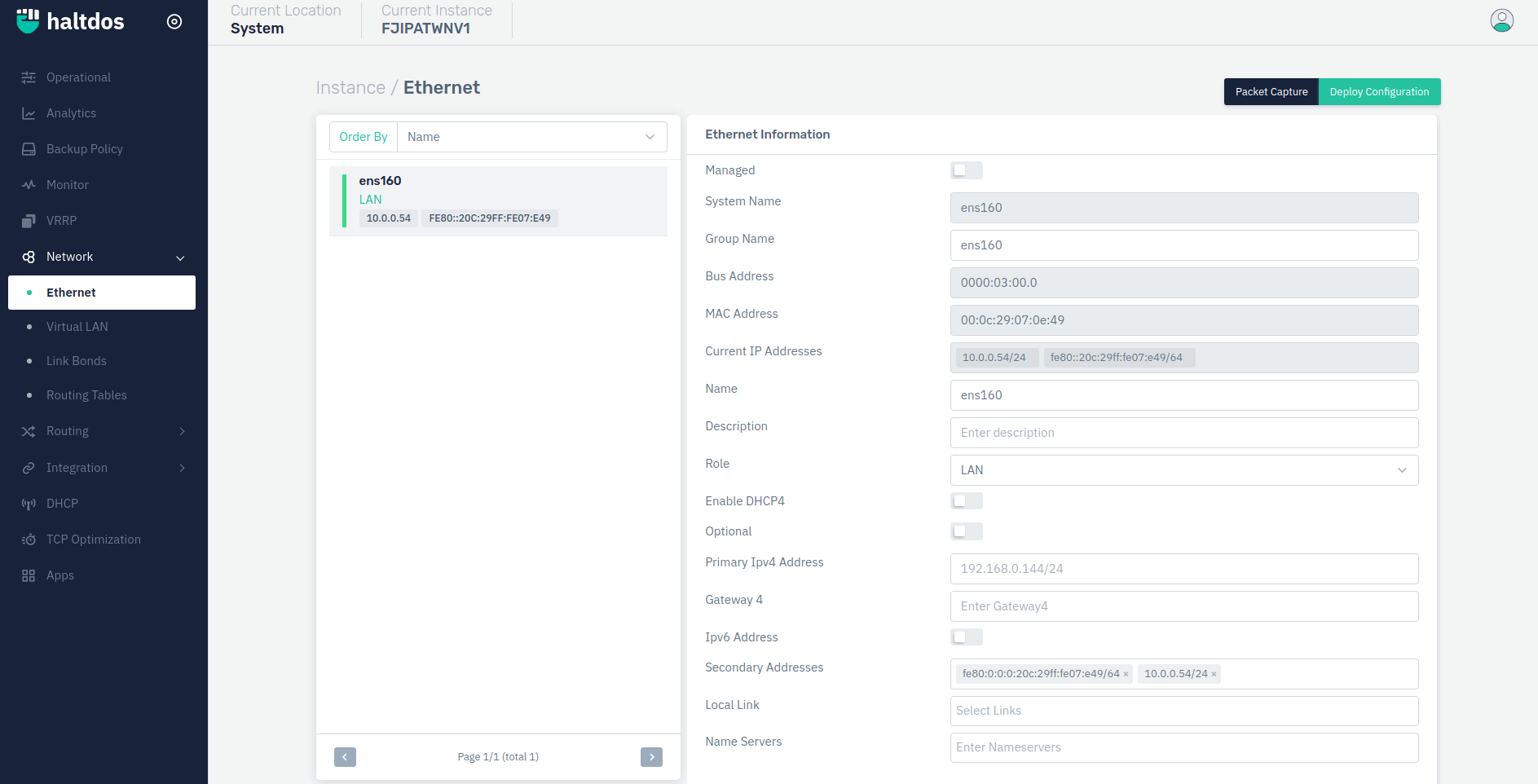Ethernet
Listing of ethernet cards (NIC) on the hardware / VM
This section allows you to configure Ethernet settings on available NIC cards on the physical or virtual instance. You can configure IP addresses, gateway, routes and routing policies per interface.
How to Use:
- Go to Stack > Instances > Network > Ethernet
- Configure your settings
- Click Save Changes

Description
System Name
The System names are Network interface names that are dynamically provided by OS. By default, they are assigned on a first-come, first-served numerical basis.
- lo – Loopback interface.
- eth0 – My first Ethernet network interface on Linux.
- vboxnet0, vmnet1, vmnet8 – Virtual machine interface working in bridge mode or NAT mode on Linux.
Managed
Users can specify if the interface is managed on OS level or not.
Accepted values: Enable / Disable
Default: Disable
System Name
It will show the system name of the interface.
Accepted values: String
Default: ens160
Bus Address
This option shows the bus address of the system.
Accepted values: String
Default: ens160
MAC Address
This option shows the MAC address of the system.
Accepted values: Integer
Default: 2
Current IP Addresses
This option shows the Current IP Addresses of the system.
Accepted values: Integer
Default: 2
Name
This option allows users to change the desired name to the Interface.
Accepted values: String
Default: ens160
Description
This option helps users to write a short description for the Interface. Users can write any information like its segment, scope, subnet information, and other notes as well.
Accepted values: String
Default: Blank
Role
This feature helps users to select the exact working mechanism of the interface, either it'll be working in the LAN segment or it'll be part of the Wide Area Network. Users can also select the third option undefined.
Accepted values: LAN / WAN / UNIDENTIFIED
Default: LAN
Enable DHCP4
Dynamic Host Configuration Protocol (DHCP) is an application layer protocol that is used to provide:
- Subnet Mask,
- Router Address,
- DNS Address,
- Gateway IP.
Accepted values: Enable / Disable
Default: Disable
Primary IP Address
This option allows users to add the primary IP address to the interface.
Accepted values: Integer
Default: Blank
Gateway 4
A gateway is a network node that forms a passage between two networks operating with different transmission protocols. This option helps the user to add the network gateway.
Accepted values: String
Default: Blank
IPv6 Address
An IPv6 address is 128 bits in length and consists of eight, 16-bit fields, with each field bounded by a colon. Each field must contain a hexadecimal number, in contrast to the dotted-decimal notation of IPv4 addresses.
Accepted values: Enable / Disable
Default: Disable
Secondary addresses
This option allows users to add their secondary IP addresses to the interface.
Accepted values: Integer
Default: Blank
Local Link
This option provides users to select the IP version of the interface. Either it is IPv4 or IPv6.
Accepted values: IPV4 / IPv6
Default: Blank
Name Servers
Nameserver is a server on the internet specialized in handling queries regarding the location of a domain name's various services. Nameservers are a fundamental part of the Domain Name System (DNS). They allow using domains instead of IP addresses.
Accepted values: String
Default: Blank
Route
Description
Route From
This option allows users to select the source node for the route. Users can specify the network ID, Host IP as well as subnet in this area.
Accepted values: String
Default: Blank
Route To
This option allows users to select the destination node point for the route. Users can specify the network ID, Host IP as well as subnet in this area.
Accepted values: String
Default: Blank
Route Via
This option allows users to set the specific hop of their desire.
Accepted values: String
Default: Blank
Route Type
This option allows users to set the type of route for this rule.
Accepted values: DEFAULT / UNICAST / UNREACHABLE / PROHIBIT / BLACKHOLE
Default: DEFAULT
Route Scope
This option allows us to set the credential.
Accepted values: DEFAULT / GLOBAL / LINK / HOST
Default: DEFAULT
Metric
Users can specify the metric value for the route defined in the rule.
Accepted values: String
Default: Blank
Route Policy
Description
Policy From
Users can specify the source IP location for which policy is being implemented.
Accepted values: String
Default: Blank
Policy To
Users can specify the destination IP location for which policy is being implemented.
Accepted values: String
Default: Blank
Policy Table
Users can specify the policy table for the policy rule.
Accepted values: Select Policy from table
Default: Blank
Policy Priority
If the user has mentioned more than one policy rule under an interface, one can define the priority value for each rule. The less priority valued rule will be called first.
Accepted values: Integer
Default: Blank
Policy Mark
Users can specify the policy mark for the policy rule.
Accepted values: String
Default: Blank
Policy Service
Users can specify the policy service for the policy rule.
Accepted values: String
Default: Blank
Users need to add 2 default routes and 2 default policies while configuring a static WAN Interface.